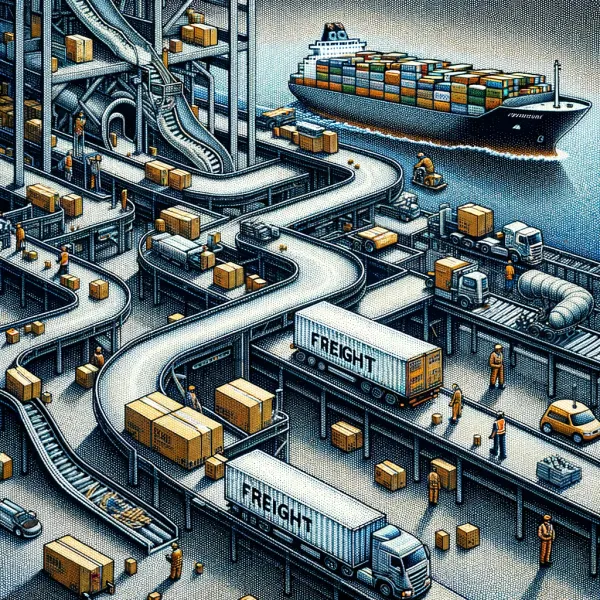
The Rise Of Innovation In Supply Chain Procurement
Written by Clay Katzman, 2023-01-05
Summary
- The rise of regionalization and reshoring has brought attention to the state of procurement. Supply chain footprints are being redrawn as a result of COVID, forcing companies to reevaluate supplier bases as they value resiliency and we cope with the concept of “sovereignty” across key sectors.
- The procurement process varies based on the company. However, typically the process can be broken down into three stages: sourcing, purchasing, and payment.
- There are interesting investment opportunities gaining traction in the procurement space. A few trends such as improved digitization of supplier management, and a deepening of supplier visibility are leading the way.
Last year, we published our thoughts on the regionalization of supply chain — which you can read about here: 🏭A Deep Dive Into Regionalization And The Implications It Has On VC.
In case you haven’t had time to read the full thesis, one of the key drivers behind regionalization are national security concerns and the drive to bring “home” industries such as semiconductors, pharmaceuticals, and electronics after experiencing the risks that come with a lack of domestic supply or capabilities. We saw the implications and risks of a lack of domestic manufacturing, and separate from that is a broader push for sustainability that brings with it the need for greater upstream visibility into procurement and supplier management. As we watch these trends unfold, we wanted to explore the current state of the procurement process and the opportunity areas that have surfaced for change.
Breaking Down The Procurement Process
The term “procurement” is rather ambiguous. To some people, it could mean the process of issuing purchase orders and making direct payments; while to other people, it encompasses all the stages, from gathering business requirements and sourcing suppliers to tracking the receipt of goods and updating payment terms (also dubbed “supplier management”). In Dynamo’s interpretation, the latter remains true. More specifically, we focused this exploration on the direct procurement process (obtaining anything that’s required to produce an end-product) as opposed to indirect procurement, which tends to focus on items related to the operation of a business rather than the creation of a product. It’s important to note that the sourcing process will vary based on the company and/or industry. Keep this in mind as you venture further down the page.
There are three stages at the core of the procurement process which we define as Sourcing, Purchasing, and Payment.
Sourcing
Sourcing, also called planning, revolves around spotting a need and taking actionable steps to fulfill it. Companies today are beginning to practice the art of strategic sourcing which is the process of assessing a company’s needs to determine how to obtain these necessities as efficiently as possible. When done correctly, strategic sourcing can reduce costs, improve supplier performance, and increase supply chain flexibility. Here are some of the most common steps found in this stage of procurement:
- Identify a need. Most of the time, this need is related to procuring more inventory, whether that be sourcing raw materials needed for a manufacturing process or acquiring more volume for that trendy, best-selling shoe. From here, an employee creates documentation, referred to as a purchase request, outlining purchase details (supplier information, volume, cost, department, etc.), then sends to the department manager for approval. In some instances, a company might submit a purchase announcement to let suppliers submit bids for the request before selecting the best contract that fits desired parameters.
- Conduct market research and vet suppliers. Once the need has been identified and approved, it’s time to figure out which suppliers to work with. Where are they located? Who have they supplied to date? Are there any factory or supplier audits that exist that show a record of delivery performance? In other words, market research is assessing the “lay of the landscape.” Once a couple of suppliers have been identified, then the analysis can begin. Key questions include: How would working with this supplier affect the bottom line? Are they capable of meeting volume and quality expectations? Will there be any potential risks that could surface if we decide to move forward?
- Negotiate contract terms. Nailing down contract terms is critical to supplier management and establishing strong relationships. Details surrounding lead times, volume, and quality control among other things are discussed during this phase with the selected suppliers during the vetting process. Many organizations use a contract management system that acts as a system of record that also makes it easier to search for certain clauses, details, or terms later down the road. As a relationship unfolds, it’s important to regularly ensure that the terms of the contract align with supplier performance.
💥Why is contract negotiation important? Consider this real-world example from McKinsey: “One consumer goods company aimed to make itself more responsive to customer demand by shortening its planning cycle from a month to a week. The company’s manufacturing and distribution functions could accommodate the change, but such short lead times had not been foreseen when many critical supply contracts were drawn up. Some of the company’s principal suppliers were simply unable to operate with lead times shorter than four weeks, and the result was widespread raw materials shortages.”
Purchasing
Purchasing takes place after contract negotiation up until pre-payment of an order. It encompasses everything from the initial transaction with the supplier to receiving the ordered shipment at a warehouse. Below are the main steps found in the traditional purchase process:
- Create a purchase order (PO). A PO is the official document that authorizes a company to procure raw materials or new inventory. Details such as a description of goods, purchase order number, quantity, unit prices, etc. are added to the PO before being sent off to a manufacturer or supplier for fulfillment. The PO is very important for tracking the status of an order and will act as the record of the purchase.
- Audit the order for quality control. Once that order has been produced, it’s important to hire a quality control inspector to ensure products meet the desired standards and expectations. After the post-production quality control checks are approved, it’s time to ship. Typically, procurement teams work hand-in-hand with supply chain teams to ensure orders are shipped and delivered in a timely manner (pending external circumstances like COVID). Procurement staff will continue to monitor the situation at arms’ length while order management and logistics are left to the supply chain staff.
- Receive the shipment and proper documentation. When the shipment arrives, it’ll come with a document called “a goods receipt” which acts as the proof of delivery. Sometimes an invoice will accompany a goods receipt once an order is received, however, that isn’t always the case. Oftentimes, the receiving department notifies Accounts Payable who will then generate an invoice that contains the original PO number, description of goods, quantity, and other important details such as unit pricing.
Payment
The final step of the procurement process is purchasing which is exactly what it sounds like; it’s the act of paying for the order, but there’s more to this last part of the procurement process than meets the eye. Purchasing is typically broken up into the three steps listed below:
- Authorize the purchase. Before payment, the order needs to be authorized through a process called three-way matching. Three-way matching simply cross-checks the invoice, goods receipts, and the original PO to ensure all details add up and match accordingly. Without some sort of management software in place, the process is time-consuming and contains a high probability of error. In some cases, a company may only compare the invoice to the PO to ensure everything is in order, a process called invoice matching.
- Record and close the order. It’s important to build an audit trail in case a problem comes up in the future. Recording the order somewhere, whether in a contract management system or supplier management system, creates a ledger that can be referenced later as a proof of payment. Recording orders also allows teams to keep track of spending and monitor the department’s budget and overall business progress. Once an order is payed for and recorded, it’s closed to indicate completion.
- Continuous supplier benchmarking. While this step isn’t necessarily found in every organization’s process, it’s important because it creates a system of accountability with a supplier. Evaluating performance in reference to the original parameters found in the contract is an ongoing process and should be communicated to a supplier if there are inconsistencies such as bad lead times, unneeded waste, or constant delays. This feedback loop is essential to the development of a relationship if that supplier is seen as a long-term partner.
Addressing The Opportunity Areas
From an investor’s point of view, it’s important to gain an understanding of the current state of procurement and the trends that are beginning to uplift and optimize the overall process. We’ve identified a few trends that will be important to monitor as you think about pulling the trigger and investing in a startup in the procurement space.
- Digitize supplier sourcing and management. The word digitization gets overused frequently, but in this case, it rings very true. While there are incumbent solutions, a search for solutions persists, consider tools that enhance supplier verification, improve the onboarding and life cycle tracking of a supplier, and update in real-time to monitor upstream risk and disruption—all at a cost that’s affordable no matter the size of a company in need
- Utilize data to create transparency. We covered earlier that gathering data and recording purchase activity is a must. The reason for this is to ensure that, in case of an audit, a company’s ducks are in a row. Data also serves as a reference check as it helps validate the financial and legal statuses of your supplier base. And, if we want to take it one step further, data capture leads to better forecasting through both internal and external data collection
- Extend deeper visibility into understanding the risk of supplier bases. One of the reasons that supply shortages oftentimes pop up to the surprise of most people is because, today, most companies only see what’s happening at their Tier 1 suppliers. Government regulation and sustainability mandates are forcing organizations to really understand what is taking place at the sub-tier level, from Tier 2 suppliers all the way to Tier 10. With a granular view, companies can not only see what is taking place at these suppliers but also have the advantage of mitigating risk in the wake of upstream disruption
- Embed the capabilities of AI. There is AI fatigue in the market but there’s no doubt that machines can map relationships and dependencies in a way that allows professionals to improve decision-making and find solutions to complex problems more effectively. AI can be intertwined into a number of applications like contract management, strategic sourcing, risk assessment, and even contract negotiation. Overtime, this will provide leverage to procurement groups who are only now recovering from the chaos COVID had on their supply chains
- Improve supplier discovery. As the global supply chain footprint continues to evolve and relocate, new relationships will be made with local/regional suppliers. Matching suppliers that fit the needed criteria of buyers, such as geographic proximity, pricing competitiveness, or sustainability requirements, is critical to improving the current discovery process
The COVID pandemic exposed multiple vulnerabilities that have long persisted throughout the global supply chain, leading to worldwide shortages and inventory stockouts. It also highlighted the growing importance of strategic sourcing and upstream supplier visibility. The shocking events that we’ve experienced over the last two years pushed organizations to consider new supplier relationships and diversification, while also fortifying existing relationships with better communication and accountability.
All in all, procurement can help increase profitability when managed efficiently. Complex products require strong relationships with suppliers to stay up-to-date and meet quality standards.
Dynamo is actively looking to invest in supporting functions within the procurement space. If you or someone you know is building a startup as such, reach out to us at [email protected].
Check out one of our other posts.


